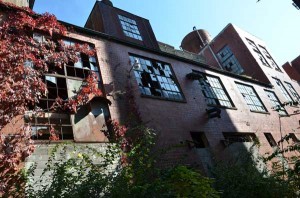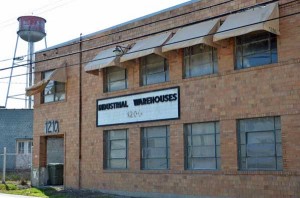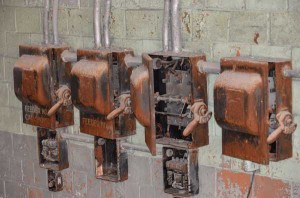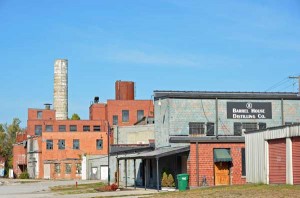The James E. Pepper Distillery and Lexington’s Lost Bourbon Industry
An Abandoned Distillery Points to Lexington, Kentucky’s Bourbon Heritage
By Richard Thomas

James E. Pepper Distillery
(Credit: Joana Thomas)
While growing up in Lexington, I never had even the slightest notion that my hometown had once been a major center of Kentucky’s bourbon industry. In my young mind, Lexington was the center of our family business, the horse business, with bourbon being something they did out in Louisville, Frankfort, Bardstown and Loretto.
My Father’s first horse farm was located in what is now a light industrial park, near where Old Frankfort Pike crosses over New Circle Road, and one of my uncles once worked at a now defunct food distributor on Manchester Street*. I would often ride in the pick-up with my Dad down onto Manchester Street, past the big quarry and on into downtown for any number of reasons, going right past the abandoned James E. Pepper distillery every single time without ever knowing the significance of that huge ruin. Imagine my surprise to discover much later in life that not only was Lexington a former distillery town, but that evidence of that heritage had been under my very nose for years.
Bourbon Distilling in the Heart of the Bluegrass
Lexington’s bourbon industry dates back to the early 19th Century, and even as early as 1810 at least 140 distilleries were operating in the vicinity of the city. Bourbon made in Lexington in those early days was destined mostly for local consumption, rather than for the whiskey trade running down to New Orleans, due to transportation limitations. Lexington was (and still is) a crossroads town, and in those pre-industrial days you needed a river to move big, bulky cargoes like dozens of barrels of whiskey.

(Credit: Joana Thomas)
Lexington only came into the whiskey trade in earnest with the arrival of the railways, particularly after the Civil War. During that “Golden Age of Distilling,” several major distilleries opened in and around the city: Ashland, Commonwealth, Silver Springs, Woodland, Lexington, and Henry Clay. The latter occupied a spot on Town Branch just west of downtown, and would later become the James E. Pepper Distillery.
James E. Pepper: The Last Still Standing
The Old Pepper Distillery is the last largely intact remnant of Lexington’s distilling history still in evidence, a testament to the distillery’s ability to survive hard times. Many of Lexington’s distilleries were driven out of business by the sustained economic difficulties of the late 1890s, and most of the companies that survived those traumas were done in by Prohibition.
The distillery’s survival through those tribulations was due primarily to two factors. The Liquor Concentration Act of 1922 dictated that what whiskey there was in the United States would be housed in a few select locations, allowing for better control of these stocks by the authorities. Also, some distillers were allowed to continue to trade in “medicinal whiskey,” a concept widely abused in Kentucky, where there were several times more prescriptions issued than there were residents of the state!
Pepper, George T. Stagg (now Buffalo Trace) and a few other distilleries in the state were lucky enough to become both medicinal whiskey-makers and concentration agents, and thereby emerged into the post-Prohibition on relatively good financial footing. None of the other Lexington-area distilleries survived Prohibition, and few traces of their existence remain standing today.

(Credit: Joana Thomas)
The Schenley Years
The James E. Pepper Distillery, along with George T. Stagg and other operations, were bought by the Cincinnati-based Schenley Products in the mid-1930s, and soon became part of the biggest distilling concern in America. The James E. Pepper brand in particular had an enduring, well-established reputation for quality, helping it rebound well into a Schenley premium product.
During the Second World War, grain shortages halted the Old Pepper Distillery’s bourbon output, but this was made up for by the production of industrial alcohol for the war effort. Anticipating another halt in bourbon production for the Korean War, the distillery tried to get ahead by operating at full production capacity and building up large stocks. However, no restrictions were imposed as a result of that war, leaving Pepper with a huge overstock, which in turn forced the distillery to cut back production. That coupled with business difficulties and the prevailing tide of consolidations into just a handful of national brands caused the closure of Lexington’s sole surviving distillery in 1958.
Distilling Comes Back to Lexington
The Pepper warehouses continued to see use down the years, but most of the distillery buildings have lain abandoned for decades. Most Lexington residents remain unaware of the significance of the Pepper Distillery, thinking it just another abandoned warehouse or factory, but the site periodically attracts architecture students, whiskey historians, and urban explorers. The curious should take note, as plans exist to redevelop Manchester Street, including the Old Pepper Distillery buildings.

at the Old Pepper Distillery
(Credit: Joana Thomas)
In recent times, Lexington has experienced something of a distilling revival. Most prominently, Alltech opened the Town Branch Distillery in the western end of downtown, less than a mile from the site of Old Pepper. Yet more pertinent is the opening of the Barrel House Distillery, occupying none other than Old Pepper’s own barrel house. Barrel House isn’t in the bourbon business, but they are making corn and sugar moonshine.
* That distributor, King’s Foods, was housed in an 1860s era warehouse leftover from the defunct Old Tarr Distillery.




Might send this for reprint to Barry McNeese, the father of the Distillery District, also the Lane Report, the Herald Leader, and most promising in my opinion Southern Living. Expanded to a tourist article, it is the kind of thing Southern Living publishes.
Thanks for sharing a little story about your life. It is a most promising story i ever read.
Lexingtonians don’t care about much of anything except how to get to the newest chain restaurant and when UK games at Rupp Arena are.